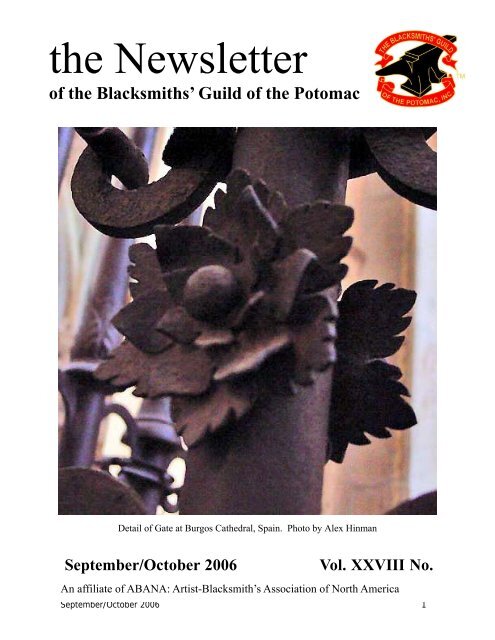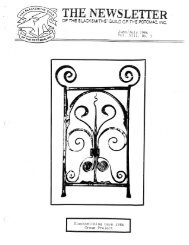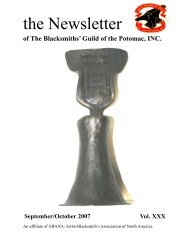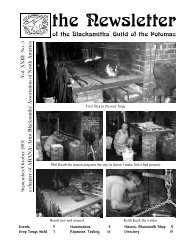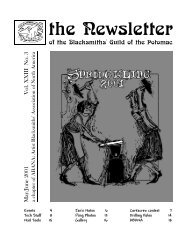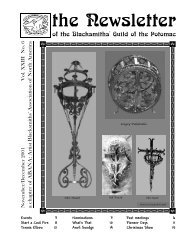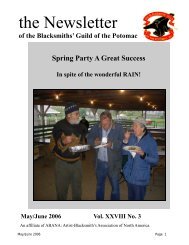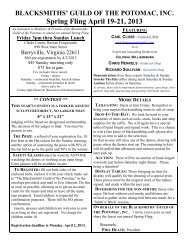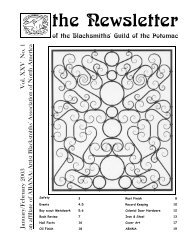Sept Oct 2006.pub - Blacksmiths' Guild of the Potomac
Sept Oct 2006.pub - Blacksmiths' Guild of the Potomac
Sept Oct 2006.pub - Blacksmiths' Guild of the Potomac
You also want an ePaper? Increase the reach of your titles
YUMPU automatically turns print PDFs into web optimized ePapers that Google loves.
<strong>the</strong> Newsletter<strong>of</strong> <strong>the</strong> Blacksmiths’ <strong>Guild</strong> <strong>of</strong> <strong>the</strong> <strong>Potomac</strong>Detail <strong>of</strong> Gate at Burgos Ca<strong>the</strong>dral, Spain. Photo by Alex Hinman<strong>Sept</strong>ember/<strong>Oct</strong>ober 2006Vol. XXVIII No.An affiliate <strong>of</strong> ABANA: Artist-Blacksmith’s Association <strong>of</strong> North America<strong>Sept</strong>ember/<strong>Oct</strong>ober 2006 1
CONTENTS4 - Schedule4 - Web Links4 - Touchstone Schedule5 - Silver Sandcasting8 - Steels Useful for Tools13 - Letter from W. Yater14 - Circle Segments15 - Vietnam Blacksmiths17 - Worsley Shop TipThis in from Tina Chisena –Paul Wagner, a friend <strong>of</strong> Tina’s,is planning on getting rid <strong>of</strong> a lot <strong>of</strong> machinetools, motors and accessories for same. He hasseveral milling machines, la<strong>the</strong>s, chucks, electricmotors, some belt sanders and o<strong>the</strong>r sundrystuff. The tools are located in <strong>the</strong> basement <strong>of</strong> aplumbing shop in Kensington, Maryland which isnow run by Paul’s son, Bill Wagner. Interestedbuyers should call his cell phone, 240-601-3623and keep in mind that <strong>the</strong> background noise levelmay be high.1943, Pitcairn, Pennsylvania. Mrs. Katie Sablejack, forty-five, a Hungarian, employed as ablacksmith's helper in <strong>the</strong> Pennsylvania Railroad yards, earning seventy-two cents perhour. She is operating a half-ton steam hammer. Mrs. Sablejack is a widow and mo<strong>the</strong>r <strong>of</strong>two children. Library <strong>of</strong> Congress, Prints & Photographs Division, FSA-OWI Collection<strong>Sept</strong>ember/<strong>Oct</strong>ober 2006 3
WEB LINKSwww.bgop.orgwww.grizzly.com/workshopplanner.aspxwww.Backyardmetalcasting.comwww.1728.com (math & geometry)http://memory.loc.gov (images at Library <strong>of</strong>Congress)CLOTHING SALESSupport your guild!. In addition to tee shirts, wehave caps <strong>of</strong> many colors, pins, tote bags in twosizes and blacksmith cook books. To place anorder or inquire about what <strong>the</strong> guild has in inventory,contact Pat McGuire.UPCOMING EVENTSSUMMER CLASSESJanuary 13-14, 2007 Bill Gichner MemorialHammer-in @Hutchison Bro<strong>the</strong>rs' Farmordova, MDadvance registration, limited attendeesJanuary 13, 2007 Open Forge atGulf Branch Nature Center, noon-4pmJanuary 20-21st, 2007 Cabin Fever Expo"The Show for <strong>the</strong> Metal Working Hobby"York Fairgrounds, York PAwww.cabin feverexpo.comA model engineering show and auctionAuction on Friday Jan. 19 by www.cabinfeverauctions.comFebruary 24, 2007 - Dan Boone Pasture Party(last Saturday in February)7381 Parrish Road, Louisa, VARSVP to Judy Boone by Feb 15 at 540-967-3267Don't forget to bring items & buy tickets for Ironin <strong>the</strong> HatMarch 2007 Patina Antique Tool Sale & Auction(2006 date was March 11)Volunteer Fire Association Activity CenterDamascus, MDTool sales in <strong>the</strong> am, auction in <strong>the</strong> pmwww.patinatools.orgApril 7, 2007 Open Forge atGulf Branch Nature Center, noon-4pmApril 21-22, 2007 - BGOP Spring FlingRuritan Fairgrounds, Berryville VASUPPORT YOUR LOCAL CRAFT SCHOOL2007 TOUCHSTONE SCHEDULEApril 27-29 Dave Olson - Letter OpenersMay 11-13 Open ForgeMay 18-20 Hammer In - Pure IronJune 4-8 Kim Thomas -June 11-15 Nigel Tudor - Traditional JoineryJune 18-22 Glenn Horr- Irons in <strong>the</strong> Fire:Beginning BlacksmithingJune 25-29 Richard Sheppard - Arch. DesignJuly 2-6 Glen Horr- Power Hammer!July 9- 3 Fred Crist - Forged Small ScaleSculptureJuly 16-20 Ray Rybar - Damascus SteelJuly 23-27 Jymm H<strong>of</strong>fmanJuly 30-Aug 3 Holly Fisher - ContemporaryApproachAugust 6-10 Bob Becker - Traditional ForgingAugust 13-17 Kirsten Skiles- ChasingAugust 20-24 Bob Rupert -<strong>Sept</strong> - 7-9 Open Forge<strong>Sept</strong> 14-15 Fall Gala<strong>Sept</strong> 28-30 Richard Sheppard - Tapestrythru Time<strong>Oct</strong> 12-14 Nigel Tudor - Effective ForgingTechniques<strong>Oct</strong> 17 - 18 Mountain Crafts WeekendTouchstone Center for Crafts1049 Wharton Furnace RdFarmington, PA 15437 USAPh: 1.800.721.0177Fax: 1.724.329.1371E-Mail: touchstone@hhs.netwww.touchstonecrafts.com<strong>Sept</strong>ember/<strong>Oct</strong>ober 2006 4
SILVER SAND CASTING5/5/06 Demo by Mark SchuknechtArticle by C. Badowski & M. SchuknechtPhotos by Dick SmithThis casting method is best used to reproducesingle medium-sized projects that donot have very fine details and undercutting. Itcan be done simply and quickly without extensiveand expensive equipment. The process requiresa model or pattern to be reproduced;casting material (sand) fine enough to capturedetails and sticky enough to hold toge<strong>the</strong>r; atwo-part frame or box to hold <strong>the</strong> sand; and aparting compound to keep <strong>the</strong> two mold halvesfrom sticking to each o<strong>the</strong>r. The mold is createdby filling <strong>the</strong> two mold frames with a damp mixture<strong>of</strong> fine grained sand and pressing a modelhalfway into each side <strong>of</strong> <strong>the</strong> box to create animpression. The model is removed, <strong>the</strong> twoboxes are fit back toge<strong>the</strong>r, and molten metal ispoured into <strong>the</strong> cavity to create a copy <strong>of</strong> <strong>the</strong>model.There are a variety <strong>of</strong> casting sands on<strong>the</strong> market, but Mark uses a syn<strong>the</strong>tic productcalled Pro-Cast available from <strong>the</strong> Rio Grandeand Thunderbird jeweler’s supply catalogs. Thecasting compound is more like a sandy-clay thanindustrial casting sand and it can be used overand over, but you do have to take care to removeand discard any burned material. It isgood for reproducing large jewelry items suchas belt buckles and bracelets. Mark uses twodifferent types <strong>of</strong> mold frames: one is a typicalcommercial two-part rectangular frame withguide pins to ensure alignment, and <strong>the</strong> o<strong>the</strong>r ismade from two alumina cylinders machined so<strong>the</strong>y fit toge<strong>the</strong>r when stacked. The two framesare open at top and bottom to allow tamping <strong>of</strong><strong>the</strong> sand from <strong>the</strong> outside.The first project was copying a BGOPbelt buckle, which Mark set up in <strong>the</strong> rectangularframe. He <strong>of</strong>ten takes a shortcut by notemptying and repacking <strong>the</strong> mold frames <strong>of</strong>casting compound each time he casts. He useda tablespoon to first remove and discard <strong>the</strong>burnt sand from <strong>the</strong> last casting, and <strong>the</strong>nscooped out casting material to create a cavitylarger than <strong>the</strong> buckle. He added enough newmaterial to make up for what was discarded andpressed it through a sieve to break up lumps,remove any impurities and lighten <strong>the</strong> texture(this is called fluffing). The casting compoundwas lightly sprinkled into <strong>the</strong> two empty halves <strong>of</strong><strong>the</strong> casting frames and spread out evenly filling<strong>the</strong> cavity. One side was made slightly concave toaccommodate <strong>the</strong> bulk <strong>of</strong> <strong>the</strong> model and <strong>the</strong> o<strong>the</strong>rside slightly convex to ensure a proper fit. Caremust be taken not to over pack <strong>the</strong> new materialuntil <strong>the</strong> impressions are made.The imprint <strong>of</strong> <strong>the</strong> buckle face was madeby firmly pressing it into <strong>the</strong> fresh fluffed castingmaterial in <strong>the</strong> bottom half <strong>of</strong> <strong>the</strong> mold. Theedges around <strong>the</strong> buckle were compacted withcare being taken to build up <strong>the</strong> casting materialalong <strong>the</strong> side <strong>of</strong> <strong>the</strong> buckle. Excess material wasscraped <strong>of</strong>f to insure that <strong>the</strong>re were no gaps, s<strong>of</strong>tspots or loose sand. This produced a slightly convexshape to <strong>the</strong> bottom half <strong>of</strong> <strong>the</strong> mold with <strong>the</strong>buckle firmly in place in <strong>the</strong> center <strong>of</strong> <strong>the</strong> mold.Then parting compound (talc) was sprinkledover <strong>the</strong> bottom section. The top half(already lightly filled with casting compound) wasgently inverted and set on top, using <strong>the</strong> guidepins for alignment and pressed into place. Hold-<strong>Sept</strong>ember/<strong>Oct</strong>ober 2006 5
<strong>the</strong> cast and he carefully inspected, cleaned andcompressed any rough spots and overhangs.Lastly <strong>the</strong> casting compound was dusted with talcand <strong>the</strong> two frames gently put back toge<strong>the</strong>ring <strong>the</strong> two pieces toge<strong>the</strong>r Mark used awooden block and hammer to compress <strong>the</strong>sandy-clay material inside <strong>the</strong> mold. Once <strong>the</strong>casting compound was firmly packed, <strong>the</strong> outside<strong>of</strong> <strong>the</strong> two sections were filled, squaredup and cleaned <strong>of</strong>f. Then very carefully <strong>the</strong>mold was split apart into its two halves. T\heoriginal belt buckle was still imbedded in <strong>the</strong>bottom half and an imprint <strong>of</strong> <strong>the</strong> back side <strong>of</strong><strong>the</strong> buckle showed on <strong>the</strong> top half. On <strong>the</strong> tophalf Mark cut out a channel to connect <strong>the</strong> impressionto <strong>the</strong> pouring spout <strong>of</strong> <strong>the</strong> mold, creatinga sprue. He did not carve vents for escapinggas on this mold, since <strong>the</strong> sprue waslarge enough to provide adequate venting.Moving on to <strong>the</strong> bottom half, Mark very carefullyremoved <strong>the</strong> belt buckle being sure not todamage <strong>the</strong> imprint. This was his final chanceto keep any gaps or loose sand from ruining<strong>Sept</strong>ember/<strong>Oct</strong>ober 2006 6
again using <strong>the</strong> guide pins for alignment. Steelplates were placed on <strong>the</strong> outside to support <strong>the</strong>exposed sand, and C-clamps used to hold everythingin pace. Too much pressure with <strong>the</strong>clamps can distort <strong>the</strong> mold, so if possible <strong>the</strong>yshould be positioned to press on <strong>the</strong> edges <strong>of</strong><strong>the</strong> frame ra<strong>the</strong>r than <strong>the</strong> center <strong>of</strong> <strong>the</strong> mold.With <strong>the</strong> mold completed and sitting upright,it was time to prepare <strong>the</strong> silver. Markuses a carbon crucible, although <strong>the</strong>re are alsoceramic and plaster ones available. He estimated<strong>the</strong> amount <strong>of</strong> silver needed for <strong>the</strong>buckle (this can be done by weight or by volume,tho he did it by <strong>the</strong> seat <strong>of</strong> <strong>the</strong> pants). Extrametal must be added to create <strong>the</strong> sprue, andMark measured that by simply using <strong>the</strong> silver in<strong>the</strong> old sprue that was cut <strong>of</strong>f from his last casting.Mark cautioned that not having enoughmetal will ruin your project so it’s better to besafe and add extra. Boric acid was added as aflux, and <strong>the</strong> crucible was placed in <strong>the</strong> coal forgewith a lid to keep ash out <strong>of</strong> <strong>the</strong> melt. He heated<strong>the</strong> metal until it was completely melted but justbelow <strong>the</strong> boiling point. When <strong>the</strong> metal reached<strong>the</strong> proper temperature(swirling andwhite hot), itwas stirred witha graphite rod toremove impuritiesand quicklybut carefullypoured into <strong>the</strong>spout on <strong>the</strong>mold frame.After <strong>the</strong> silver had cooled a bit, Mark removed<strong>the</strong> clamps and separated <strong>the</strong> frame sectionsto free <strong>the</strong> silver casting. Finishing wasn’tdone in <strong>the</strong> shop, but involves cutting <strong>of</strong>f andfiling <strong>the</strong> sprue as well as any flashing where <strong>the</strong>silver spread between <strong>the</strong> mold sections. Allscrap metal is saved for future melts, and filingscan hoarded and sent <strong>of</strong>f for refining. A finalbuffing and soldering on any mechanical parts(like a pin for <strong>the</strong> buckle), and <strong>the</strong> piece is done.<strong>Sept</strong>ember/<strong>Oct</strong>ober 2006 7
Steels Useful for Toolsby Dave SmuckerReprinted with permission <strong>of</strong> <strong>the</strong>Appalachian Area Chapter <strong>of</strong> BlacksmithsWhat is important in a tool steel? Why dowe have so many different types?Well, mostly because no one steel can doall things for all people and do it at a low cost. Itis kind <strong>of</strong> like you can have a hard steel, a toughsteel, a low distortion steel, a lower cost steel --pick any two <strong>of</strong> <strong>the</strong> four. In o<strong>the</strong>r words, a steelcan be designed for a given application -- butusually is a mixture <strong>of</strong> various trade-<strong>of</strong>fs.If you want to select a steel for a givenapplication or tool, you need to look at <strong>the</strong> followingcharacteristics:1. Heat resistance or hot hardness. Howdoes it perform at higher temperatures?Can we use it on hot metal?2. Shock resistance. How tough is <strong>the</strong>steel? How strong? What is <strong>the</strong> depth <strong>of</strong>hardness?3. Wear resistance. How well does it handleabrasion, how well does it hold an edge?How hard is it?4. Machinability. How easy is it to saw, drilland machine in its s<strong>of</strong>t or annealedstate?5. Forgeability. How easy is it to forge?How small is <strong>the</strong> forging temperaturerange? Does it go “hot short”?6. Ease <strong>of</strong> heat-treating. What is used toquench from critical temperature: water,oil, air, etc.? How prone to cracking is<strong>the</strong> steel on quenching? How much doesit distort?7. Availability. While cost is a factor, inmost cases “availability” to <strong>the</strong> blacksmithin small quantities and reasonablesizes is <strong>the</strong> big issue. In addition, can wefind <strong>the</strong> material as scrap?How do alloying elements affect <strong>the</strong>secharacteristics?Carbon (C) is <strong>the</strong> basic element thatgives tool steels <strong>the</strong>ir hardness and lets us do<strong>the</strong> heat-treating. It is essential in low alloy toolsteels -- needs to be 0.60 percent (or 60 points)and higher. At <strong>the</strong> high end <strong>of</strong> <strong>the</strong> percentagerange, up to 1.00 percent plus (100 + points <strong>of</strong>carbon) it adds considerably to <strong>the</strong> wear resistance.It is <strong>the</strong> element that makes <strong>the</strong> very importantblacksmith tool steel W1 what it is.Manganese (Mn) improves forgeabilityand reduces brittleness. In low alloy tool steels,it may allow <strong>the</strong> use <strong>of</strong> oil for quenching in someapplications.Silicon (Si) is not a major element inmost tool steel but is important in <strong>the</strong>ir manufactureas a deoxidizer. In conjunction withManganese, it is important in S5, which is anextremely tough Silicon-Manganese tool steelwith outstanding shock and abrasion resistance.S5 was <strong>the</strong> tool steel most favored by my preretirementemployer (Alcoa) for use in air hammertooling used by <strong>the</strong> brick masons. Alcoauses a great number <strong>of</strong> <strong>the</strong>se tools in rebuildingmelting furnaces.Tungsten (W) is a very important elementin many tool steels giving both hot hardnessand wear resistance. T1 (18.0 percentTungsten) was <strong>the</strong> first <strong>of</strong> <strong>the</strong> high-speed toolsteels used for cutting tools in machine shops. Ithas been around since about 1900.The chemical symbol W is from <strong>the</strong> Germanname for <strong>the</strong> element “Wolfram”. (My Germanfriends don’t call it TIG welding but ra<strong>the</strong>r WIGwelding.)Vanadium (V) acts as a grain refinerand thus improves <strong>the</strong> forgeability <strong>of</strong> <strong>the</strong> toolsteel. It also forms a very hard Vanadium carbinethat improves both hardness and wear. Inlarge amounts (above 1.0 percent), it makes <strong>the</strong>tool steel much harder to grind.Molybdenum (Mo) At low percentagesMoly improves both deep hardening and toughness.In high percentages, it is used in sometool steels to replace Tungsten.Cobalt (Co) increases <strong>the</strong> hot hardness<strong>of</strong> tool steels used in some cutting tool applications.It also increases <strong>the</strong> critical temperaturemaking heat-treating more difficult and leadingto decarburization.Chromium (Cr) is a major alloying elementin many tool steels improving hardenability(depth <strong>of</strong> hardness) and can improve both wearresistance and toughness. We find it in manysteels including <strong>the</strong> alloy steels, 4140 (chromemoly engineering steel), 5160 (spring steel) and52100 (bearing steel) all <strong>of</strong> which are useful toblacksmiths because we can find <strong>the</strong>m at lowcost as scrap.<strong>Sept</strong>ember/<strong>Oct</strong>ober 2006 8
Nickel (Ni) Used with o<strong>the</strong>r elements,such as chrome, to improve <strong>the</strong> toughness <strong>of</strong>some tool and alloy steels. An important elementin L6.What tool and alloy steels are useful to <strong>the</strong>Blacksmith?With all <strong>of</strong> <strong>the</strong> above as just so much informationyou may be saying, OK, what tool steelsare useful to me as a blacksmith, how do I forgeand heat-treat <strong>the</strong>m and where can I find <strong>the</strong>stuff? What follows is my opinion on some <strong>of</strong> <strong>the</strong>tool and alloy steels based on my industrial andblacksmithing experience.I sure would like to hear from some <strong>of</strong> youon your experience and what has worked and notworked for you for various blacksmithing applications.I would like to report that information infuture articles. Here is what I think <strong>of</strong> some <strong>of</strong><strong>the</strong>se steels:TOOL STEELSW1 also sometimes found as 1095and as “Water hardening drill rod.” This is<strong>the</strong> basic old-line blacksmithing tool steel. Formany applications, it remains one <strong>of</strong> <strong>the</strong> beststeels for <strong>the</strong> blacksmith. It is defined as a coldwork tool steel, since it loses its hardness at hotmetal temperature -- and <strong>the</strong>refore is not a hotworking tool steel. It still is a good steel for makingpunches and cold cuts. I like it for things like“eye” punches. You just have to remember to coolit after each use to avoid drawing <strong>the</strong> temper.Francis Whitaker used it for making a greatdeal <strong>of</strong> his tooling and I believe liked it for thingslike hammers. (I prefer 4140 or 1080 for hammers.)It makes some <strong>of</strong> <strong>the</strong> finest woodworkingtools and many <strong>of</strong> <strong>the</strong> knife makers use it a greatdeal. Most old files are made from W1. It requiresquenching with water to obtain good hardness.Because <strong>of</strong> this, <strong>the</strong> depth <strong>of</strong> hardness is limited(usually about a max. <strong>of</strong> 0.060 inch) and tools retaina ra<strong>the</strong>r tough core. I think that W1 and howto use it should be part <strong>of</strong> <strong>the</strong> blacksmith basicknowledge or “tool kit”.Clay Spencer uses W1 for a lot <strong>of</strong> histreadle hammer tool. He like it for most tools with<strong>the</strong> exception <strong>of</strong> hot cuts.H13, Hot work tool steel. Ano<strong>the</strong>r <strong>of</strong>my favored tool steels, this time for making toolsintended for long exposure to hot metal. This includeshot cuts, hot hardies and heavy-dutypunches. It also makes good drifts for openingup holes etc., although I use 5160 spring steelfor most <strong>of</strong> <strong>the</strong>se.The hot work tool steels were developedfor heavy hot working industrial applicationssuch as forging dies, extrusion dies and hot millrolls. The reason to use H13 over any <strong>of</strong> <strong>the</strong>o<strong>the</strong>r “H” steels is that you can find it in smallsections both round and plate.It is available in small quantities and anumber <strong>of</strong> smiths sell it as a “tail gate” item atvarious blacksmith meetings. Reportedly, it isalso used in guide pin application in plasticmolding and may be available to use as dropsfrom some “die shops”. It is an air-quenchingtool steel, and very difficult to anneal with simpleequipment. So if you want to saw it or machineit, that needs to be done before any forgingor heat treatment.Joe Miller loves H13 and uses it forboth hot tools and a number <strong>of</strong> <strong>the</strong> cold workdies he uses under his power hammers. Hehas had very good life in this application usingit in many production runs.S7, A Shock-Resisting Tool Steel canbe found in some jackhammer tools or bits (<strong>the</strong>ycan also be S1 or S5). It is a very tough steelthat takes impact loading extremely well. It alsohas good hot work properties and is used in applicationsup to 1000 degrees F. I have used itfor hot cuts, and for that application don’t seeany major difference from H13. Many blacksmithsmake hardies from S7, where <strong>the</strong>y haveobtained <strong>the</strong> steel from old jack hammer bits.Some blacksmiths have used S7 to makespecial power hammer tools where <strong>the</strong>y machineda pattern into <strong>the</strong> tool and <strong>the</strong>n usedthat tool on hot metal under <strong>the</strong> power hammer.It is an air hardening (air quenching) tool steeland heat treating it is much like working withH13. Because it is air hardening and very tough,many machine shops like it for tooling applicationsand it has replaced O1 in many tooling applications.You can buy it in most common drillrod sizes.Some manufacturers make <strong>the</strong>ir powerhammer dies from S7.If I could have only one tool steel in additionto W1, it would be S7. I know manyblacksmiths love H13 but I really think that for<strong>Sept</strong>ember/<strong>Oct</strong>ober 2006 9
TOOL STEELSLetterSymbolCategory Designation Group Designation Some Typical End UsesMTHigh-Speed Tool Steels(<strong>the</strong> M is for Molybdenum)High-Speed Tool Steels(<strong>the</strong> T is for Tool ormaybe Tungsten?)Molybdenum typesTungsten types (<strong>the</strong>chemical symbol forTungsten is W)Drill bits, end mills, taps, threadingdiesMilling cutters, la<strong>the</strong> bitsH1 –H19Hot-Work Tool Steels(<strong>the</strong> H is for Hot)Chromium typesHot cuts, extrusion dies, hot millrollsH20 -H39Hot-Work Tool Steels(<strong>the</strong> H is for Hot)Tungsten typesExtrusion dies, hot forging diesH40 -H59Hot-Work Tool Steels(<strong>the</strong> H is for Hot)Molybdenum typesSpecial high temperature hotworkDCold-Work Tool Steel(<strong>the</strong> D is for Die)High carbon, highchromium typesMetal forming dies (cold work)coining dies, tread rolling diesACold-Work Tool Steel(<strong>the</strong> A is for Air)Medium alloy, airquenching typesDie casting, shear knifes, trimmingdiesOCold-Work Tool Steel(<strong>the</strong> O is for Oil)Oil quenching typesDrawing dies, coining dies, diecasting diesWSWater-quenching ToolSteel, also a Cold-WorkTool SteelShock-Resisting ToolSteel (<strong>the</strong> S is for Shock)Low alloy, high carbon(<strong>the</strong> W is forwater quenching)Lower carbon, alloyedfor toughnessHand tools, blacksmith tools,wood working toolsPneumatic Chisels, Blacksmithingand boilermaker’s toolsPMold Steels (P is forplastic)Carburizing steel(case hardening)Plastics moldsLSpecial-Purpose ToolSteels (L is for Low alloy)Low-Alloy types(L6, does have 1.5percent nickel)Large sawmill band saw bladesFSpecial-Purpose ToolSteels (F is for, ”I don’thave a clue”)Carbon-tungstentypeSome abrasion-resistant applications<strong>Sept</strong>ember/<strong>Oct</strong>ober 2006 10
Name Category or type Make up <strong>of</strong> steel Some typical uses4140 or4340Engineering steel,widely use for equipmentapplicationsChrome Moly steel or ChromeMoly Nickel steel -- 0.40 C4119 Timken bearing steel Deep case hardened used inroller bearing from Timken5160 Coil and flat springsteelALLOY STEELSMedium high carbon chromesteel with 0.60 C52100 Ball Bearing Steel Most non Timken bearings Toolinghammers, tongs, anvil tools,power hammer tooling, powerhammer diesBoth rollers and races can bereforged into toolsDrifts, punches, and power hammertooling.8620 Case hardening steel --gearingRailroadrail,Specification is inweight per yard, such as115 pound railNickel Chrome Moly steelused in case hardening applicationsSteel varies by manufacturerbut is similar to 1080 withabout 1 percent manganeseTongsPower hammer tooling, hammersmost applications, both hot and cold, that S7 iseven better.O1, is not a tool steel that I like – Iuse ei<strong>the</strong>r A2 or S7 or even W1 instead, but youwill find it as one <strong>of</strong> <strong>the</strong> most common drill rodsteels. (It was widely used by machine shopsbecause <strong>of</strong> low distortion in heat treatment. TodayA2 fills that bill better.)A2, The most common air hardening(air quench) tool steel in <strong>the</strong> USA today. Ihaven’t used this steel for blacksmithing tools,but like it very well for tools and gauges etc.that are machined and <strong>the</strong>n heat treated. Somefolks have made woodworking tools from A2.Steve Williamson has made a number <strong>of</strong>his hand held punches out <strong>of</strong> A2 and likes it for<strong>the</strong>se tools.4140 and 4340 are <strong>the</strong> most commongeneral purpose engineering steels today. Usedfor many equipment applications, I like <strong>the</strong>sesteels for making hammers and tongs. Manysmiths use mild steel for making tongs, but I liketo use ei<strong>the</strong>r 4140 or 4340 because <strong>of</strong> <strong>the</strong>irmuch greater strength and toughness. This allowsyou to make <strong>the</strong> tongs with thinner jawsalong with smaller and springier reins or handles.The one major limitation with <strong>the</strong>se alloytongs is that you can’t quench <strong>the</strong>m from a redheat. You must let <strong>the</strong>m cool well into <strong>the</strong> blackrange if you are going to cool <strong>the</strong>m in your slacktub.5160, Spring steel, found in someautomotive coil and most flat springs. I like thissteel for power hammer tooling and for heavyduty, "bash on it tooling" like drifts. I have evenmade a few hot cuts and punches from this material.From time to time I have had crackingproblems with some <strong>of</strong> this material -- likelyfrom cracks already in <strong>the</strong> old springs. Not allsprings are 5160 so your results may depend on<strong>the</strong> type <strong>of</strong> steel in <strong>the</strong> spring. Read <strong>the</strong> articleon "Break-Testing".Railroad rail or 1080 steel with <strong>the</strong>addition <strong>of</strong> about 1 percent manganese. Avery high quality, very clean steel that makesgood hammers and power hammer dies. Youcan buy this material as scrap at reasonableprices. If you are going to try to saw railroadrail, cut from <strong>the</strong> bottom up -- as <strong>the</strong> rail head isusually work hardened. If you have a powerhammer, you can work rail into very useful sectionsfor many tool applications. It's not quite ashigh in carbon as W1 but still at 0.80 carbon willheat-treat very well as water quench steel. Forsmall tools, you can use an oil quench.<strong>Sept</strong>ember/<strong>Oct</strong>ober 2006 11
Rebar is Junk, not quality scrap steeluseful for tools. It is one material I think youare really wasting your time trying to use fortools. I also don't think A36 is useful for muchexcept handles and tongs. A36 can be usedfor female dies for use in <strong>the</strong> treadle or powerhammer, but if you can make <strong>the</strong>se out <strong>of</strong>better material, you will get much longer life.If you want more information, backgroundor detail on <strong>the</strong>se and o<strong>the</strong>r steels, see<strong>the</strong> following references:Machinery's Handbook, now in its 27th edition editedby Robert E. Green and Christopher J.McCauley. Industrial Press Inc. (I was using <strong>the</strong>25th for this article. Every blacksmith, machinist ormechanical engineer should have a copy <strong>of</strong> thishandbook. You can find older editions <strong>of</strong> this book atgood prices in <strong>the</strong> used book market.)Heat Treatment, Selection and Application <strong>of</strong> ToolSteels, by Bill Bryson, Hanser Gardner PublicationsEngineering Properties <strong>of</strong> Steel, Philip D. Harvey Editor,American Society for MetalsCopyright 2001, 2005 by David E. SmuckerNote to o<strong>the</strong>r editors <strong>of</strong> blacksmith newsletters:Youare free to use this article in your publicationprovide you used it in its entirety andcredit <strong>the</strong> Appalachian Area Chapter <strong>of</strong> Blacksmithsand author. I can provide you with anelectronic copy by contacting me at davesmucker@hotmail.comIt may not be reproducedin any form for commercial use.December 5, 20061943, Topeka, Kansas. Workmen manipulating a hot forging which is being hammeredunder a steam hammer in <strong>the</strong> blacksmith shop <strong>of</strong> <strong>the</strong> Atchison, Topeka andSanta Fe Railroad. Library <strong>of</strong> Congress, Prints & Photographs Division, FSA-OWI Collection.<strong>Sept</strong>ember/<strong>Oct</strong>ober 2006 12
A Letter fromWallace Yater21118 Mousetown Rd, PO Box 51Boonsboro, Maryland 21713 or301-432-5789 or 202-337-0341Dear B.G.O.PLast March at age 80 <strong>the</strong> ra<strong>the</strong>r wellknown knifemaker <strong>of</strong> Middletown, Maryland WilliamF. ‘Bill’ Moran died <strong>of</strong> colon cancer. Bill was one <strong>of</strong><strong>the</strong> 27 founding members <strong>of</strong> ABANA. He founded<strong>the</strong> American Bladesmiths’ Society and taught <strong>the</strong>arts involved in knife making at <strong>the</strong> Rochester Institute<strong>of</strong> Technology and at <strong>the</strong> University <strong>of</strong> Arkansasat Washington, Arkansas where <strong>the</strong>y built aschool room with student forges.During Bill’s unpleasant bout with coloncancer he and a retired IBM executive, Earl J. ‘Jay’Hendrickson <strong>of</strong> 4204 Ballenger Creek Pike, Frederick,Maryland 21703 301-663-6923, an accomplishedbladesmith in his own right, discussed usingBill’s shop or a recreated equivalent and Bill’sapproximately $2.5 million dollar estate to create aknifemaking museum in <strong>the</strong> Frederick County area.Bill made Mr. Hendrickson executor <strong>of</strong> his estatewhich means complete control over <strong>the</strong> estate andcreation <strong>of</strong> <strong>the</strong> museum. Bill and Jay decided tosell Bill’s house at 6612 Jefferson Blvd., BraddockHeights, probably mainly to have more funds for<strong>the</strong> museum and to be relieved <strong>of</strong> <strong>the</strong> maintenance<strong>of</strong> it.Any museum to be successful needs acommunity outreach program, an education program,and interest and involvement from <strong>the</strong> surroundingcommunity. This is especially importantnow that so much <strong>of</strong> <strong>the</strong> manual or industrial artsclasses have been taken out <strong>of</strong> our schools andreplaced in most cases by ‘computers’, which maytell you how to do a fire weld, but are completelyuseless at letting one actually experience doing itand <strong>of</strong>ten suffering <strong>the</strong> many failed attempts beforeactually doing a successful weld. There is ahuge difference between just reading about somethingand actually doing it.Bill’s house on Braddock’s Mountain wasauctioned <strong>of</strong>f November 18 and not wanting to seeit go out <strong>of</strong> <strong>the</strong> Blacksmithing community for awhile longer I stretched my resources and endedup <strong>the</strong> high bidder. My plan is to freshen up 95years <strong>of</strong> grime with fresh paint and some neededrepairs and rent and hold it for enough years tosee if <strong>the</strong> executor does his thing, <strong>the</strong> communityresponds and <strong>the</strong> Moran Foundation turns out tobe enough <strong>of</strong> a success to benefit from having <strong>the</strong>actual house Bill lived in for <strong>the</strong> last 44 years <strong>of</strong> hislife. It is my hope that <strong>the</strong> foundation eventuallygets and uses <strong>the</strong> house. It is all wait and see.I plan to do much <strong>of</strong> <strong>the</strong> work myself. I amhoping BGOP would have some members who wouldhelp with some <strong>of</strong> <strong>the</strong> work Walkersville Sou<strong>the</strong>rn RailroadStyle, that is, making a church social out <strong>of</strong>things like repairing 4 miles <strong>of</strong> track and scraping andpainting rolling stock.The Moran house work is all inside. Thehouse has heat, running water, and kitchen and Ihave enough mattresses and o<strong>the</strong>r camping gear toaccommodate a number <strong>of</strong> people. I plan to tacklemuch <strong>of</strong> it during <strong>the</strong> long, cold miserable haulthrough January, February and March after <strong>the</strong> funfamily things like Thanksgiving, Christmas and NewYear’s have been used up and all that is left to celebrateis Ground Hog Day, St. Patty’s Day, <strong>the</strong> IRS anda lot <strong>of</strong> cold wea<strong>the</strong>r.On K Street near Connecticut Ave. N.W. inD.C. is a thing called <strong>the</strong> Foundation Center, whichhas branches in many o<strong>the</strong>r places. This is like a librarywhere one can go to do research on <strong>the</strong> 37,000foundations in this country to search for funds for aparticular project. Out <strong>of</strong> <strong>the</strong>se 37,000 foundationsyou must find <strong>the</strong> subset that proclaims an interest inyour particular field. You have to contact <strong>the</strong>ir directorsto see if <strong>the</strong>y would have an interest in your particularproject as well as funds available for it which isusually not <strong>the</strong> case. This is a very long, drawn-out,time-consuming process requiring <strong>the</strong> persistence andresistance to frustration and defeat characteristic <strong>of</strong>an experienced hardened salesman. You have tokeep in mind that <strong>the</strong>re really is a lot <strong>of</strong> money out<strong>the</strong>re, that is why a dollar today buys what 3 cents didin 1943 and that a lot <strong>of</strong> really good programs havebeen funded this way. In addition, any time schoolsand or “inner city kids at risk” are brought in <strong>the</strong>re isan addition to this a wide variety <strong>of</strong> governmentalfunding sources available.The executor, Mr. Hendrickson, is openminded and willing to listen to and consider most suggestionsand proposals. The Moran Foundation nowhas 501c3 (section <strong>of</strong> IRS Tax code) non-pr<strong>of</strong>it statusbut many, probably most, details <strong>of</strong> <strong>the</strong> final nature <strong>of</strong>it are still in a state <strong>of</strong> flux as <strong>the</strong> executor interactswith what comes in from <strong>the</strong> surrounding community.Call or write Wallace M. Yater, 21118 MousetownRoad, P.O. Box 51, Boonsboro, Maryland 21713or 301-432-5789 or 202-337-0341.Very truly yoursWallace without Gromit,his sensible dog that keeps gettingNick Park’s version out <strong>of</strong> trouble<strong>Sept</strong>ember/<strong>Oct</strong>ober 2006 13
CIRCLE SEGMENTSThis template for dividing a circle has been making<strong>the</strong> rounds but is too useful to pass up, sowe’re taking it from <strong>the</strong> New England Blacksmiths’newsletter and passing it on to you. To divide acircle into equal parts, connect <strong>the</strong> appropriatenumber to <strong>the</strong> center for <strong>the</strong> division you need.For example, <strong>the</strong> points marked 5 divide <strong>the</strong> circleinto fifths.Cool Tip—on-line math and geometry calculatorscan be found on <strong>the</strong> web at www.1728.com.# <strong>of</strong>SegmentsDegree <strong>of</strong>Angle3 1204 905 726 607 51.4288 45(INSERT CIRCLE SEGMENTDIAGRAM HERE)<strong>Sept</strong>ember/<strong>Oct</strong>ober 2006 14
VIETNAM BLACKSMITHSThanks to Rob Whitehurst <strong>of</strong> Louisiana for sharing <strong>the</strong>se shopphotos he took in Vietnam:The two shots at right were taken in <strong>the</strong> village <strong>of</strong> Da Si, inHa Tay Province right outside <strong>of</strong> Ha Noi. The town is knownfor its blacksmiths and literally every o<strong>the</strong>r dwelling has asmall shop attached to it. They have a festival every yeardedicated to <strong>the</strong> craft. The "Standout Handblower" is a basicshop-made blower: I took this so that <strong>the</strong> next time someonetells me that <strong>the</strong>y can't get started because <strong>the</strong>y don't have ablower, I can show <strong>the</strong>m this photo. Three <strong>of</strong> <strong>the</strong> shots on<strong>the</strong> next page are from <strong>the</strong> blacksmith on <strong>the</strong> road to My Laioutside <strong>of</strong> Quang Ngai. Of <strong>the</strong> smiths I visited he showed <strong>the</strong>most skill, primarily building <strong>the</strong> sort <strong>of</strong> axe machete that all<strong>the</strong> rural peasants in <strong>the</strong> central part <strong>of</strong> <strong>the</strong> country carry.The photo with lunch heating on <strong>the</strong> forge, and also <strong>the</strong>"Standout Handblower" are from <strong>the</strong> "street <strong>of</strong> iron smiths" inHa Noi, one <strong>of</strong> <strong>the</strong> ancient streets in <strong>the</strong> oldest section <strong>of</strong> HaNoi which was named after <strong>the</strong> trade which was historicallyfollowed <strong>the</strong>re. I had to visit that one to see if anything wasleft, and found half a dozen shops sort <strong>of</strong> hanging on in smallground-level "store fronts".<strong>Sept</strong>ember/<strong>Oct</strong>ober 2006 15
Standout Handblower<strong>Sept</strong>ember/<strong>Oct</strong>ober 2006 16
A tip-top shop tip from Chris Worsley:Years ago at <strong>the</strong> dawn <strong>of</strong> time, I needed to weld a rod to a piece <strong>of</strong> plate to make along handled peel for <strong>the</strong> kitchen at Sully Plantation. Well, <strong>the</strong> difficulty was getting <strong>the</strong>plate and rod, being quite different in size, up to welding heat at <strong>the</strong> same time, andkeep <strong>the</strong> two parts from flopping around while trying to weld while doing it alone. FayP. LeCompte III had <strong>the</strong> answer.- Punch a hole in <strong>the</strong> plate where you want <strong>the</strong> handle welded.- Taper <strong>the</strong> rod so it fits into <strong>the</strong> hole and is long enough to pein down like a rivet.- Pein <strong>the</strong> end <strong>of</strong> <strong>the</strong> rod down so it holds tightly to <strong>the</strong> plate- Now, <strong>the</strong> area to be welded could go into <strong>the</strong> fire firm without having to worry aboutsliding about, or having to hold <strong>the</strong> two pieces toge<strong>the</strong>r when <strong>the</strong>y came up to weldingheat.- Rod on <strong>the</strong> bottom for <strong>the</strong> heat since it was thicker than <strong>the</strong> plate.- After welding, I dressed up <strong>the</strong> plate, drew out <strong>the</strong> rod to <strong>the</strong> needed length for <strong>the</strong>handle and decorated with a simple twist and hook on end for hanging from <strong>the</strong> mantle.Murphy's Law in <strong>the</strong> Forge:The shop phone will always ring exactly when welding heat is reached.Bell by Bill ClemensSee future issue forarticle & instructions!<strong>Sept</strong>ember/<strong>Oct</strong>ober 2006 17
BGOP Membership Application and RenewalNameHome Phone________________AddressWork PhoneCity State ZipI am a member <strong>of</strong> ABANA, The Artist Blacksmiths Association <strong>of</strong> North America Yes NoNew Member—$35 or 3 yrs—$75 Renewal—$25 or 3 yrs—$70Age _______________(Minimum 16 years) Blacksmithing Experience ______ Yes NoMake check payable to: BGOPMail check and Membership application to: Fred Long, 5309 Bangor Dr, Kensington MD 20895-1106Gulf Branch Nature Center3608 N. Military RoadArlington VA 22207703-358-3403To Chain Bridge, Rt123 and Glebe RdBGOPshopNatureCenterMilitaryRoadLogCabinParkingTo Lorcum Lane, Rt 29,Spout Run and GeorgeWashington ParkwayName:Address:City:State:Country:Zip/PC:Type <strong>of</strong> Membership Regular.......... $55 Overseas ......$65 Student .......... $45 Contributing ...$100 Senior (65+)... $50 Library............$45ABANA Chaper Affiliation:Application may also be made at <strong>the</strong> ABANA website: www.abana.orgE-mail:www url:Phone:Fax:Credit Card Information□VisaCard#□MastercardExpiration Date:Submit check, money order (US banks only), or by credit card:LeeAnn Mitchellabana@abana.orgABANAPO Box 816 Phone: 706.310.1030Farmington GA 30638 Fax: 706.769.7147M E M B E R S H I P A P P L I C A T I O N<strong>Sept</strong>ember/<strong>Oct</strong>ober 2006 18


